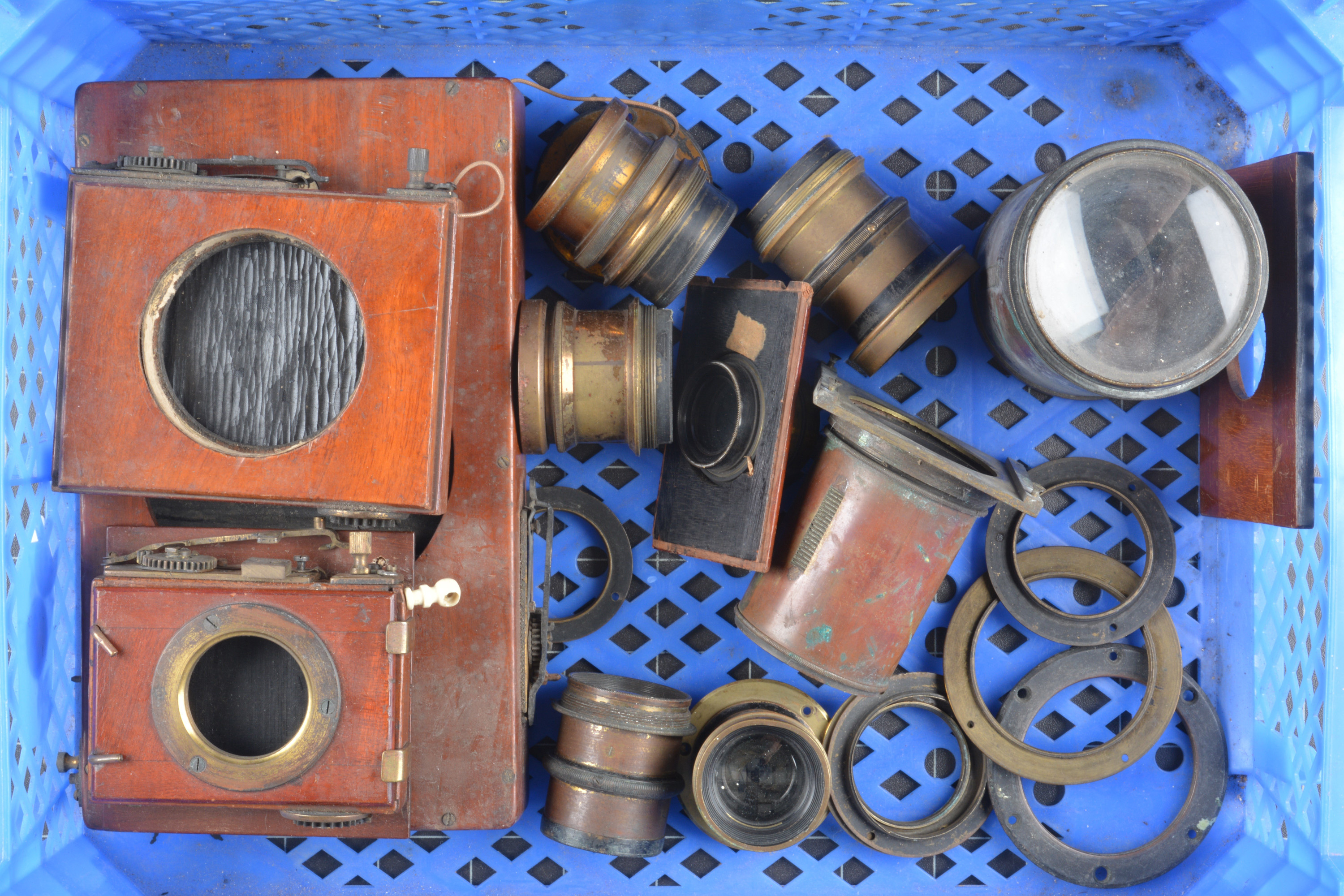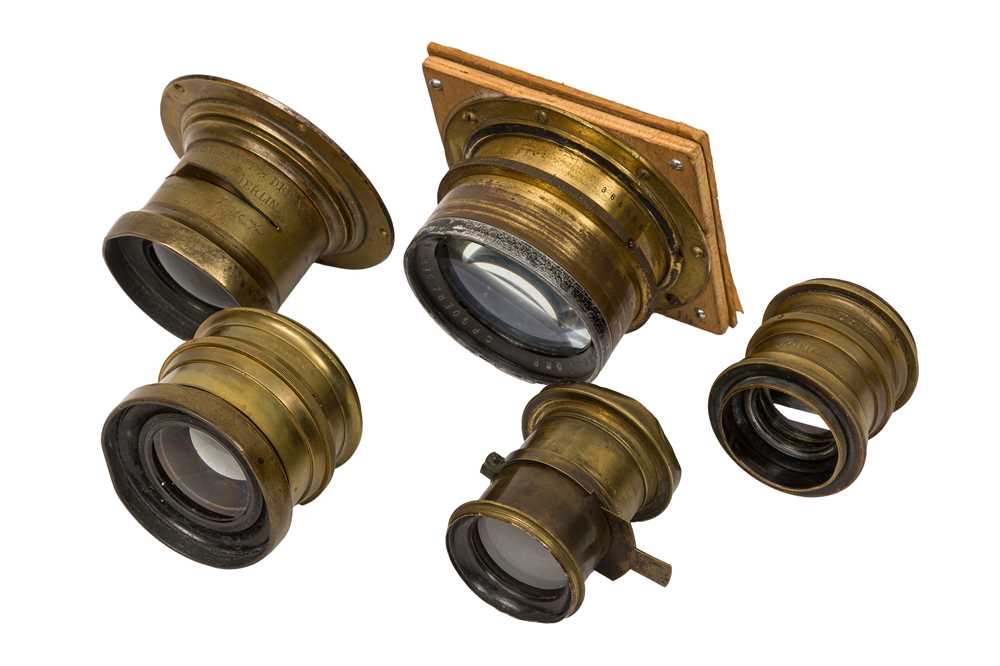4 Brass Lenses from England 1) Watson & Sons. "12 x 10 Premier", c. 1875, no. 5510, probably an aplanatic lens, iris stop (stuck), approx. 45 cm focal length, height approx. 6 in., lens diameter approx. 2 ¾ in., light dent in rear lens mount. (3/4) - 2) Early landscape lens from England, c. 1865, unmarked, approx. 12 cm focal length, for 6 x 9 cm cameras, for waterhouse stop, with slot on front, height 2 in., Ø 2 in., connecting ring Ø 2 ¾ in. (2/2) - 3) Charles Cheetham Vevers. "C.C. Vevers Leeds ½ Plate", c. 1900, lens with focal length of approx. 25 cm, rotating stop, height 2 in., Ø 2 in. (3+/3+) - And: 4) Watson & Sons. "4.2 in Holos Wide Angle", convertible lens, c. 1910, no. 2696, front lens with engraving "Front 8 in", back lens with "Back 6 ¾ in", thus the lens could provide 3 different focal lengths: 4,2, 6 ¾ and 8 in. With iris diaphragm and 2 aperture scales, height 32 mm. (3+/2-3) 4 Messingobjektive aus England 1) Watson & Sons. "12 x 10 Premier", um 1875, Nr. 5510, ein wohl aplanatisches Objektiv, Irisblende (verstellbar, aber nicht in Ordnung), Brennweite ca. 45 cm, Bauhöhe ca. 15 cm, Linsendurchmesser ca. 70 mm. Leichte Delle an der hinteren Objektivfassung. (3/4) - 2) Frühes englisches Landschaftsobjektiv, um 1865, unbezeichnet, ca. 12 cm Brennweite, für Bildkreis von ca. 6 x 9 cm, für Steckblenden (vorne), Höhe 5 cm, Ø 5 cm, Anschraubring Ø 7 cm. (2/2) - 3) Charles Cheetham Vevers. Universalobjektiv "C.C. Vevers Leeds ½ Plate", um 1900, Brennweite ca. 25 cm, Rotationsblende, Höhe 5 cm, Ø 5 cm. Außergewöhnliche, kurze Bauart für ein Objektiv mit 25 cm Brennweite (3+/3+) - Und: 4) Watson & Sons. Satzobjektiv "4.2 in Holos Wide Angle", um 1910, Nr. 2696, vorderes Objektiv mit Gravur "Front 8 in", hinteres Objektiv mit "Back 6 ¾ in". So ergeben sich drei Brennweiten: 4,2, 6 ¾ und 8 in. Mit Irisblende und 2 Blendenskalen, Höhe 3,2 cm. (3+/2-3)
4 Brass Lenses from England 1) Watson & Sons. "12 x 10 Premier", c. 1875, no. 5510, probably an aplanatic lens, iris stop (stuck), approx. 45 cm focal length, height approx. 6 in., lens diameter approx. 2 ¾ in., light dent in rear lens mount. (3/4) - 2) Early landscape lens from England, c. 1865, unmarked, approx. 12 cm focal length, for 6 x 9 cm cameras, for waterhouse stop, with slot on front, height 2 in., Ø 2 in., connecting ring Ø 2 ¾ in. (2/2) - 3) Charles Cheetham Vevers. "C.C. Vevers Leeds ½ Plate", c. 1900, lens with focal length of approx. 25 cm, rotating stop, height 2 in., Ø 2 in. (3+/3+) - And: 4) Watson & Sons. "4.2 in Holos Wide Angle", convertible lens, c. 1910, no. 2696, front lens with engraving "Front 8 in", back lens with "Back 6 ¾ in", thus the lens could provide 3 different focal lengths: 4,2, 6 ¾ and 8 in. With iris diaphragm and 2 aperture scales, height 32 mm. (3+/2-3) 4 Messingobjektive aus England 1) Watson & Sons. "12 x 10 Premier", um 1875, Nr. 5510, ein wohl aplanatisches Objektiv, Irisblende (verstellbar, aber nicht in Ordnung), Brennweite ca. 45 cm, Bauhöhe ca. 15 cm, Linsendurchmesser ca. 70 mm. Leichte Delle an der hinteren Objektivfassung. (3/4) - 2) Frühes englisches Landschaftsobjektiv, um 1865, unbezeichnet, ca. 12 cm Brennweite, für Bildkreis von ca. 6 x 9 cm, für Steckblenden (vorne), Höhe 5 cm, Ø 5 cm, Anschraubring Ø 7 cm. (2/2) - 3) Charles Cheetham Vevers. Universalobjektiv "C.C. Vevers Leeds ½ Plate", um 1900, Brennweite ca. 25 cm, Rotationsblende, Höhe 5 cm, Ø 5 cm. Außergewöhnliche, kurze Bauart für ein Objektiv mit 25 cm Brennweite (3+/3+) - Und: 4) Watson & Sons. Satzobjektiv "4.2 in Holos Wide Angle", um 1910, Nr. 2696, vorderes Objektiv mit Gravur "Front 8 in", hinteres Objektiv mit "Back 6 ¾ in". So ergeben sich drei Brennweiten: 4,2, 6 ¾ und 8 in. Mit Irisblende und 2 Blendenskalen, Höhe 3,2 cm. (3+/2-3)















Testen Sie LotSearch und seine Premium-Features 7 Tage - ohne Kosten!
Lassen Sie sich automatisch über neue Objekte in kommenden Auktionen benachrichtigen.
Suchauftrag anlegen